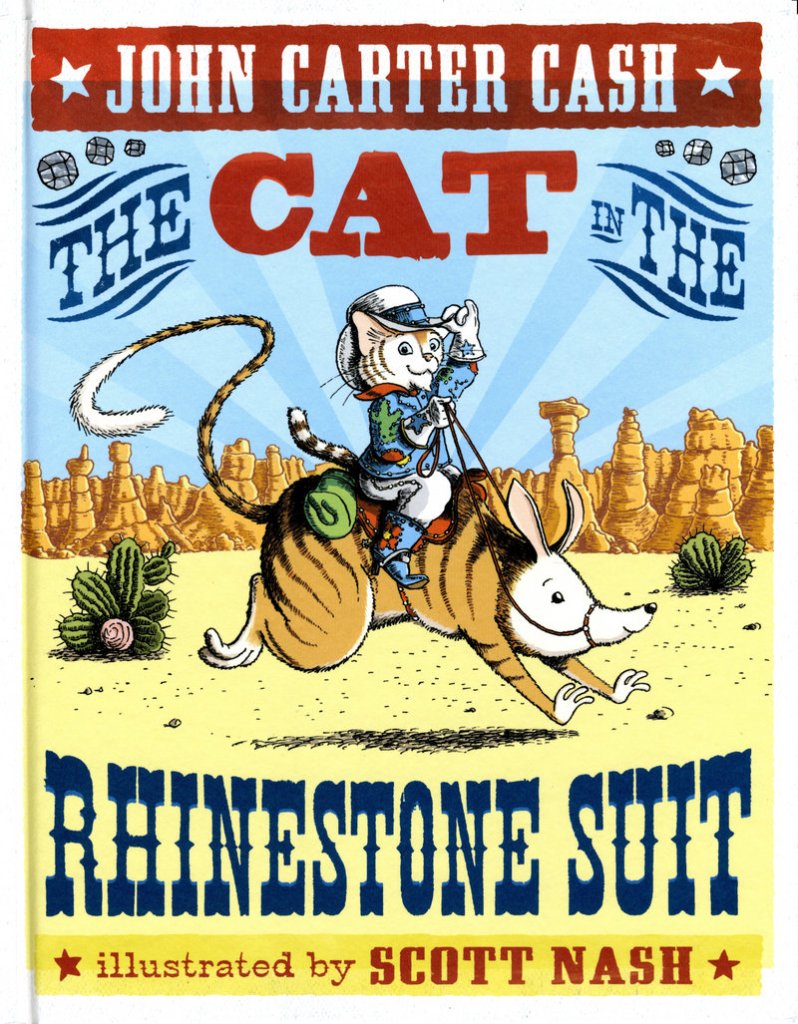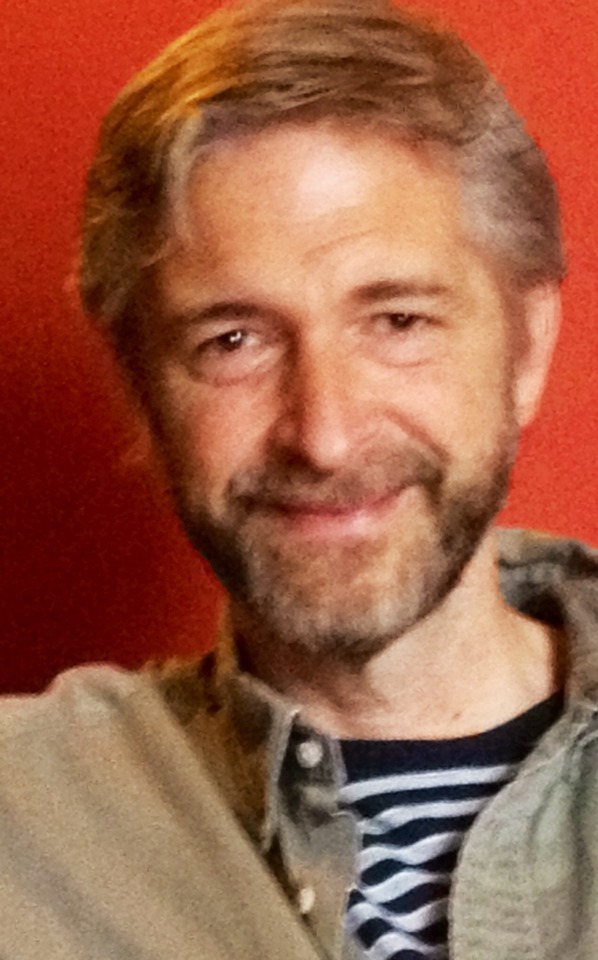Scott Nash knows a good song when he hears one. He knows it when he reads one too.
“The Cat in the Rhinestone Suit” struck him as a winner. Written by John Carter Cash, son of the late Johnny Cash and June Carter Cash, the words connected with Nash’s creative spirit right away.
A dapper cat in boots rides into town on a bandicoot, followed by a mouse in a wide-brimmed hat riding a camel. The cat confronts his nemesis, a rattlesnake named Del Moore.
Nash, an award-winning illustrator who lives on Peaks Island, could not wait to get to work on the song, which Carter Cash had written in a book for children. Published by Little Simon Inspirations, the book is out this week.
Nash is a big-time illustrator. He’s worked with Jeff Brown on the “Flat Stanley” series, and has done work for kid-centric PBS, Nickelodeon and Disney, among other brands.
This is a big year for Nash. In September, Candlewick Press will publish his homage to Robert Louis Stevenson, “The High Skies Adventures of Blue Jay the Pirate,” an epic novel that he has labored over for five years. This summer, he takes over as chair of the illustration department at Maine College of Art.
We recently sat down for a chat at his Union Street office in Portland on a rainy weekday morning.
Q: How did this association with John Carter Cash come about? Did the publisher contact you?
A: Two things you should know about me. Besides my passion for art, I really love music. I am a terrible musician, but I love to play music, and I love to listen to live music. The other thing is, I’ve always had this attraction to Nashville. Two years ago, I had an opportunity to go to Nashville on business. On this one morning, I came into the office and there was some excitement. An associate said, “Hey Scott, before you do anything, you need to read this e-mail we just received.” It said, “Dear Mr. Nash, I am admirer of your work. I am an author of a number of books. I’ve written children’s books and novels. I am also a music producer and musician. I have written a children’s book that I think would be appropriate for us to work on. I look forward to your response.” It was signed John Carter Cash.
I know the Cash legacy, and could certainly put together that it was in fact Johnny Cash’s son. Short story, I called him up, and he turned out to be a very amiable fellow. I told him I was coming down to Nashville the very next week, so I was able to squeeze in a meeting with him on the Cash estate. Our meeting was held in the little log cabin that Johnny Cash and June Carter Cash had turned into a state-of-the-art music studio. I drove up to the place. There was this burly, friendly gentleman standing outside with a little goatee, and he introduced himself as John Carter Cash.
I walked into the studio, and it was full of music memorabilia. It had Johnny Cash’s guitars, Annie Leibovitz’s famous portrait of Johnny Cash that was done in his later life, it had recording equipment. I found myself completely swept away with the experience of being there.
He and I sat down, and we talked about illustration and the book he had written, although I did not read it while I was there. In the end, we walked into this one room that I hadn’t seen, and again there was a lot of memorabilia. There was a framed music notation that caught my eye. I walked over toward it, and it was a handwritten transcription by Johnny Cash to John Carter Cash of how to play “I Walk the Line.” Down below, it said, “Keep working on this, son, and later I will give you another lesson” — or something to that effect — “Love, Dad.”
And I noticed next to that was this big, rough-hewn wooden mantle, and this mantle had signatures scrawled all over it — Elvis Costello, Lucinda Williams, Dolly Parton — and it was just signed with all of these musicians I thoroughly admire. And there was this one funny area where Bob Dylan had written his name, and there was a halo around it where no one could write. I said, “Oh my gosh, this is great.”
I pored over it for while, and I turned around and John said, “Here, I want you to sign it as well.” I moved over toward Bob Dylan, and he kindly sort of moved my arm down by Kris Kristofferson. So that’s where I am, over by Kris Kristofferson.
Q: What struck you about his writing?
A: He had written a manuscript that essentially is a song. It is written in song form, a cowboy ballad. I see it as a surreal cowboy ballad. It’s about a cat in a rhinestone suit who may be slightly vain. He rides a bandicoot with a mouse that rides a camel. From an illustration standpoint, I just found it delightful material to be working with.
In his mind, this story is his retelling of the Good Samaritan. To me, it’s just a rollicking, surreal cowboy ballad that does have a very satisfying ending. It’s not a traditional story in any way, but it does take on the structure of some Bible stories. As much as I am not a practicing Christian, I find Bible stories interesting.
Q: How do you describe your style with this book?
A: I’m going through changes. I am coming back to my roots and working in pen and ink. All I want to do these days is scratch away with an old steel nib and make these types of illustrations. I’m not painting as much. I am tinting these in Photoshop, but I find something very satisfying with using a tool that is sort of arcane with some of the available technology. It’s actually called a crow quill, or a hawk quill. It’s an old technique. It goes back to the 17th century.
Q: Are you teaching this to your students?
A: I certainly am. I am trying to get them to stop using the manufactured pens, which I call soulless. The Microns and some of the manufactured pens are meant to dry out and give you one consistent line. The nibs allow you to get some variation in line.
There is significant interest at Maine College of Art in combining arcane art forms with technology. They may not have been familiar with the crow quill, but once I put them in their hands, some really do take to it. They realize they are getting a whole other level of expression with a crow quill that they would not necessarily get with Microns.
Q: I know you have some thoughts about e-books vs. printed books. Care to expound?
A: There is a lot perseverating about what is going to be happening with books. I don’t have any answers in that regard. I have speculations.
I don’t believe that printed books are going to be going away, in any way. I believe that what we’re going to see is higher craft in books. I am seeing lots of evidence that supports the notion that books that are beautifully crafted are things that we are going to want to continue to have on our shelves.
On the other side, I am disappointed with what’s out there in e-books — I find it a fairly cold medium. I think that we are in our boring phase of that technology. I think the potential, on the other hand, is quite interesting, and I don’t think that we’ve even started to tap the potential of e-books.
We think of the revolution as being from print to electronic form. What I think the potential revolution for e-books is to really rethink the way that we approach writing narratives. I think e-books afford us the opportunity to create narratives that change with time. There is a lot that can be played with. It is a much more malleable form than a printed book is, and for those reasons I find e-book publishing quite intriguing.
Staff Writer Bob Keyes can be contacted at 791-6457 or:
bkeyes@pressherald.com
Twitter: pphbkeyes
Send questions/comments to the editors.





Success. Please wait for the page to reload. If the page does not reload within 5 seconds, please refresh the page.
Enter your email and password to access comments.
Hi, to comment on stories you must . This profile is in addition to your subscription and website login.
Already have a commenting profile? .
Invalid username/password.
Please check your email to confirm and complete your registration.
Only subscribers are eligible to post comments. Please subscribe or login first for digital access. Here’s why.
Use the form below to reset your password. When you've submitted your account email, we will send an email with a reset code.